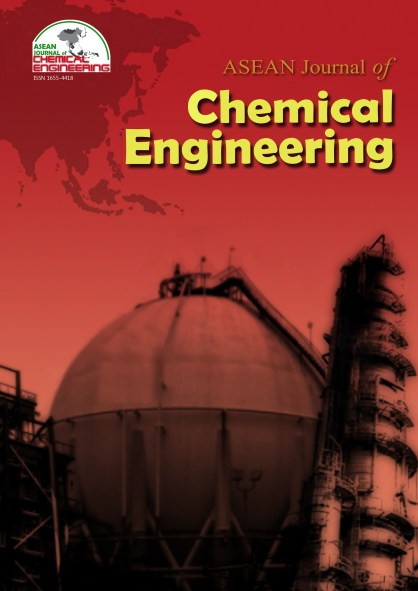A Study on the Relative Performance of Different Coagulants and the Kinetics of COD in the Treatment of a Textile Bleaching and Dyeing Industrial Wastewater
Bleaching and dyeing industrial wastewater
Abstract
Untreated wastewater from textile industries when discharged to nearby waterways would cause considerable health concerns to humans and animal life and to the host environment. They contain various chemicals such as dyes, detergents and surfactants, some of which are recalcitrant to biodegradation. Such wastewater can be better remediated by chemical treatment. The treatment of a textile bleaching and dyeing industrial wastewater was done by Coagulation and Flocculation Method using a jar test apparatus. Alum, polyaluminum chloride (PAC), and ferrous sulfate were used in separate runs as coagulants, while excelfloc 264 (a polyacrylamide copolymer) was used as flocculant. Preliminary tests were first conducted to determine the appropriate coagulation and flocculation agitation rates and settling time. The initial pH of the sample effluent was varied from 5 to 8 for alum coagulation, 5 to 8.5 for PAC coagulation and 9 to 11 for ferrous sulfate coagulation. The dosages of each coagulant and the excelfloc were varied from 200 to 1000 ppm, and 0.5 to 2.5 ppm, respectively. Experimental results showed that the optimum initial pH of the wastewater using alum, PAC, and ferrous sulfate were 7, 7.5, and 10, respectively. The optimum dosages of the coagulants were found to be 600ppm for alum and 800ppm for both PAC, and ferrous sulfate. The optimum flocculant dosages were 1.5ppm with alum, 1 ppm with PAC and 2ppm with ferrous sulfate. The highest percentage removal of COD, Total Suspended Solids (TSS), Total Dissolved Solids (TDS), chromium, and color were found to be 58.55%, 65%, 36.51%, 76.45%, and 78.96%, respectively, using alum: 65.4%, 67.5%, 35.84%, 44.92%, and 75.49%, respectively using PAC; and, 55.72%, 34.16%, 33.95%, 19.88%, and 48.56%, respectively, using ferrous sulfate. Among the three coagulants tried, coagulation with PAC gave the highest percentage of COD removal of 65.64% and TSS removal of 67.5% while alum gave the highest removal of both chromium and color at 76.45% and 94.49%, respectively. Rapid and slow agitation rates used were 240rpm for 1 minute and 40rpm for 20 minutes, respectively; while settling time was 30 minutes. Kinetics of the COD removal was studied at the optimum conditions. Kinetic model, determined by curve fitting with the coagulation/flocculation reaction, was observed to follow a first-order rate of reaction.
References
2. Chichcean Kan et al. (2002).”Time requirement for rapid-mixing in coagulation.” Colloids and Surfaces A: Physicochem. Eng. Aspects 203, 1–9.
3. Clescerl, Lenore S., Greenberg, Arnold E. and Eaton, Andrew D. (2003). “Standard Methods for Examination of Water & Wastewater”, 20th Edition, Washington, D.C. American Public Health Association
4. Duk Jong Joo et al. (2005) “Decolorization of reactive dyes using inorganic coagulants and synthetic polymer,” Dyes and Pigments, 1-6.
5. Huseyin, Selcuk (2004). “Decolorization and detoxification of textile wastewater by ozonation and coagulation processes.” Dyes and Pigments, 217-222.
6. J. P., Lorimer et al. (2001). “Degradation of dye effluent,” Pure Appl. Chem., 73, 12, 1957–1968.
7. Levenspiel, Octave (1962). Chemical reaction engineering, 1st Edition, John Wiley & Sons, Inc.
8. M. Banat, Ibrahim, Nigam, Poonam, Singh, Datel and Marchant, Oger (1996). “Microbial decolorization of textile-dye- containing effluents: A review,” Bioresource Technology 58, 217-227.
9. Metcalf and Eddy Inc. (2003). Wastewater engineering: treatment, disposal and reuse, 4th Edition, TATA McGraw-Hill Publishing Co., Ltd., New Dehli.
10. Vera, Golob, Vinder, Aleksandra and Simonic, Marjana (2005). “Efficiency of the coagulation/flocculation method for the treatment of dyebath effluents.” Dyes and Pigments 67, 93-97.
Copyright holder for articles is ASEAN Journal of Chemical Engineering. Articles published in ASEAN J. Chem. Eng. are distributed under a Creative Commons Attribution-NonCommercial 4.0 International (CC BY-NC 4.0) license.
Authors agree to transfer all copyright rights in and to the above work to the ASEAN Journal of Chemical Engineering Editorial Board so that the Editorial Board shall have the right to publish the work for non-profit use in any media or form. In return, authors retain: (1) all proprietary rights other than copyright; (2) re-use of all or part of the above paper in their other work; (3) right to reproduce or authorize others to reproduce the above paper for authors’ personal use or for company use if the source and the journal copyright notice is indicated, and if the reproduction is not made for the purpose of sale.



